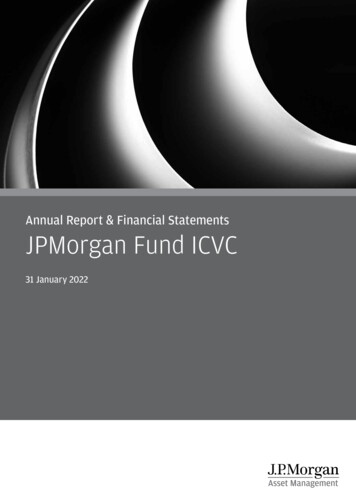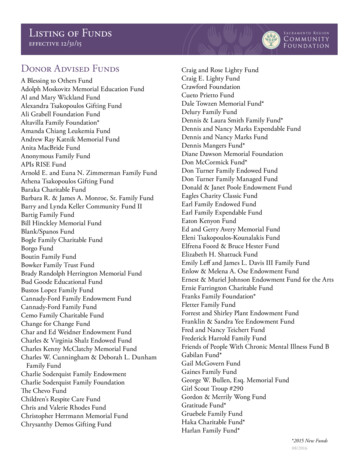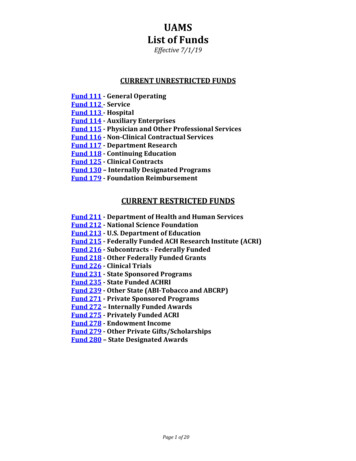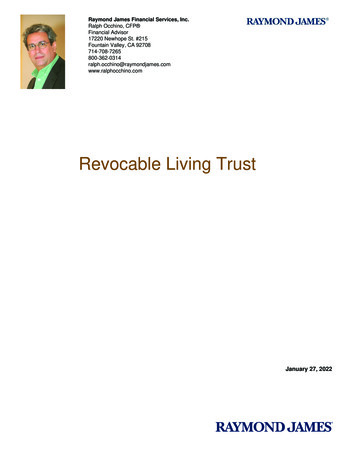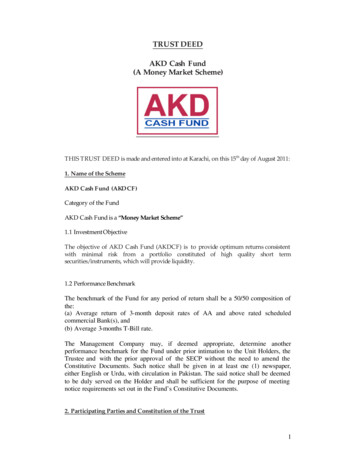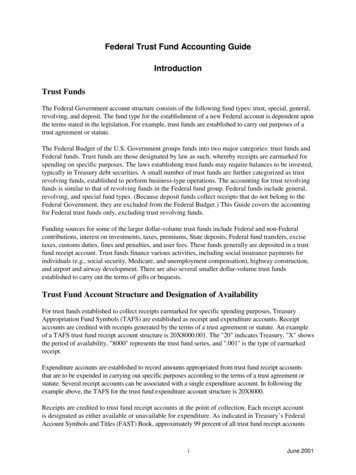
Transcription
Federal Trust Fund Accounting GuideIntroductionTrust FundsThe Federal Government account structure consists of the following fund types: trust, special, general,revolving, and deposit. The fund type for the establishment of a new Federal account is dependent uponthe terms stated in the legislation. For example, trust funds are established to carry out purposes of atrust agreement or statute.The Federal Budget of the U.S. Government groups funds into two major categories: trust funds andFederal funds. Trust funds are those designated by law as such, whereby receipts are earmarked forspending on specific purposes. The laws establishing trust funds may require balances to be invested,typically in Treasury debt securities. A small number of trust funds are further categorized as trustrevolving funds, established to perform business-type operations. The accounting for trust revolvingfunds is similar to that of revolving funds in the Federal fund group. Federal funds include general,revolving, and special fund types. (Because deposit funds collect receipts that do not belong to theFederal Government, they are excluded from the Federal Budget.) This Guide covers the accountingfor Federal trust funds only, excluding trust revolving funds.Funding sources for some of the larger dollar-volume trust funds include Federal and non-Federalcontributions, interest on investments, taxes, premiums, State deposits, Federal fund transfers, excisetaxes, customs duties, fines and penalties, and user fees. These funds generally are deposited in a trustfund receipt account. Trust funds finance various activities, including social insurance payments forindividuals (e.g., social security, Medicare, and unemployment compensation), highway construction,and airport and airway development. There are also several smaller dollar-volume trust fundsestablished to carry out the terms of gifts or bequests.Trust Fund Account Structure and Designation of AvailabilityFor trust funds established to collect receipts earmarked for specific spending purposes, TreasuryAppropriation Fund Symbols (TAFS) are established as receipt and expenditure accounts. Receiptaccounts are credited with receipts generated by the terms of a trust agreement or statute. An exampleof a TAFS trust fund receipt account structure is 20X8000.001. The "20" indicates Treasury, "X" showsthe period of availability, "8000" represents the trust fund series, and ".001" is the type of earmarkedreceipt.Expenditure accounts are established to record amounts appropriated from trust fund receipt accountsthat are to be expended in carrying out specific purposes according to the terms of a trust agreement orstatute. Several receipt accounts can be associated with a single expenditure account. In following theexample above, the TAFS for the trust fund expenditure account structure is 20X8000.Receipts are credited to trust fund receipt accounts at the point of collection. Each receipt accountis designated as either available or unavailable for expenditure. As indicated in Treasury’s FederalAccount Symbols and Titles (FAST) Book, approximately 99 percent of all trust fund receipt accountsiJune 2001
are designated as available. An available receipt account carries the same symbol as itscorresponding expenditure account. Amounts credited to available receipt accounts are appropriatedimmediately, without further legislative action, into the corresponding expenditure account. These1amounts may then be invested if the legislation prescribes.A trust fund’s designation of availability for investment has no bearing on whether it is available forobligation. For receipts collected that are not immediately available for obligation, the Office ofManagement and Budget (OMB) requires that budget authority and unobligated balances be excludedfrom the SF 133: Report on Budget Execution and Budgetary Resources. However, if the lawdesignates the receipts as available for investment, Treasury requires that unobligated balances bereported on the USSGL 2108: Year-End Closing Statement. This presents a disconnect in the reportingof unobligated balances, which Treasury and OMB acknowledge as a reconciling item. Receiptsclassified as available for investment but not obligation are discussed in Scenario III, Trust FundReceipts Available for Investment but not Obligation.Not all funds received by trust funds are deposited to trust fund receipt accounts. For example, amountsare credited directly to trust fund expenditure accounts when nonexpenditure transfers occur.Nonexpenditure transfers are accomplished via an SF 1151: Nonexpenditure Transfer Authorization, andinclude both appropriation and allocation transfers. Refer to Scenario I, Basic Trust Fund Accounting, forfurther discussion.Refer to the flowchart at the end of this section for a basic illustration of a trust fund account structureand flow.Scenario PresentationThis Guide is categorized into eight scenarios. The scenarios address specific topics approved by theUSSGL Board. Each scenario begins with a narrative describing the events that follow. Additionalscenarios will be forthcoming as guidance is further developed. This Guide also will be updatedperiodically to include new and revised USSGL account titles and transaction descriptions. Thescenarios are as follows: Scenario IScenario IIScenario IIIScenario IVScenario V Scenario VI Basic Trust Fund AccountingTrust Fund Balances Precluded from ObligationTrust Fund Receipts Available for Investment but not ObligationTrust Fund InvestmentsTreasury-Managed Trust Fund Allocation AccountsTrust Fund Appropriation Transfers for Specific Treasury AppropriationFund SymbolsScenario VII Trust Funds with Contract Authority – Part I: Appropriations to LiquidateContract Authority – Funded by Nonexpenditure TransfersScenario VIII Trust Funds with Contract Authority – Part II: Transfers of ContractAuthority1TFM Vol. I Part 2 - Chapter 1500 states that "all trust funds with investment authority are designated as available receipts inthe Treasury system, even if the receipts of the trust fund are not available to the agency for obligation."iiJune 2001
Scenario GuidelinesThe following concepts apply to each scenario: The scenarios are not all inclusive of the different types of revenues and/or expenses thatmay be recorded by a trust fund entity. The intent is to illustrate the main concepts throughbasic transactions recorded by trust funds. Refer to Section III, Accounting Transactions, ofTFM S2-01-02 (as updated) for a complete listing of USSGL accounts that may be recordedby trust funds. Section III is located on the USSGL Web site. Trust funds may or may not be subject to apportionment. Apportionments may apply to all ora portion of a trust fund. The scenarios vary in nature as to whether the trust fund is subject toapportionment. Refer to Section III, Accounting Transactions, of TFM S2-01-02 (as updated)for a complete listing of transactions. Budgetary and financial reports reflect the pertinent lines to be reported based on theindividual scenarios. For full presentations of the reports and line descriptions, refer to theappropriate authoritative guidance (see References section below).ReferencesThis Guide has been developed based on research of current reference materials and input from Treasury,OMB, and agency representatives. The references listed below should be used in conjunction with thisGuide to determine the proper accounting and reporting treatment required of each individual Federaltrust fund. The references are as follows: Agency’s establishing legislation and/or annual appropriation language Appendix to the Budget of the United States Government FASAB's SFFAS #7: Accounting for Revenue and Other Financing Sources OMB Bulletin 97-01: Form and Content of Agency Financial Statements OMB Circular A-11: Preparation and Submission of Budget Estimates OMB Circular A-34: Instructions on Budget Execution and Budgetary Resources Treasury Financial Manual references U.S. Government Annual Report - AppendixCommon Terms and AbbreviationsCommon terms and abbreviations used in this Guide are as follows:ATBBudgetFASABFAST BookFACTSAdjusted Trial BalanceAppendix to the Budget of the United States GovernmentFederal Accounting Standards Advisory BoardFederal Account Symbols and Titles BookFederal Agencies' Centralized Trial-Balance SystemiiiJune 2001
USSGL 2108GuideOMBOPACP&FSF 133SF 1151SFFASUSSGLTAFSTARTreasuryTFM"B""E""E-B"Yearend Closing StatementFederal Trust Fund Accounting GuideOffice of Management and BudgetOn-line Payment and Collection systemProgram and Financing ScheduleReport on Budget Execution and Budgetary ResourcesNonexpenditure Transfer AuthorizationStatements of Federal Financial Accounting StandardsUnited States Standard General LedgerTreasury Appropriation Fund SymbolTreasury Annual ReportU.S. Department of the TreasuryTreasury Financial ManualDesignation used directly after a USSGL account (e.g., 4114B) to indicatebeginning balance requiredDesignation used directly after a USSGL account (e.g., 4114E) to indicate endingbalance requiredDesignation used directly after a USSGL account (e.g., 4114E-B) to indicateending minus beginning balance requiredRelevant Web SitesWeb sites relating to this Guide are as .treasury.gov/fsreports/ref/ussgl/ussgl home.htmivJune 2001
Scenario IBasic Trust Fund AccountingScenario I includes transactions and reports illustrating basic accounting for receipts and collections,expenditure transfers, nonexpenditure transfers, and exchange/nonexchange transactions. FASAB’sSFFAS #7, Accounting for Revenue and Other Financing Sources, prescribes the majority of proprietaryaccounting contained in this scenario. (Refer to Scenario IV, Trust Fund Investments, for discussion oninvestment transactions.)A basic concept of trust fund accounting is that trust funds do not use USSGL accounts 3100Unexpended Appropriations or 5700 Expended Appropriations (refer to SFFAS #7, paragraph 213). Atleast two justifications support this concept.First, trust funds do not receive Treasury appropriation warrants, for which Fiscal Service Form 6200:Appropriation Warrant is issued from the General Fund of Treasury as a result of an appropriation act.USSGL account 3100 Unexpended Appropriations generally is associated with these types of warrants.Instead, the source of most trust fund inflows includes receipts and collections that are either depositeddirectly into trust funds or first collected by a custodial entity.Second, trust fund receipts predominantly consist of tax receipts (e.g., social security taxes, railroadretirement taxes, and excise taxes), as well as customs duties, fines, penalties, etc. Collecting entitiessuch as the Internal Revenue Service and the U.S. Customs Service collect these receipts and depositthem into Treasury general fund receipt accounts.SFFAS #7 states that dedicated tax receipts, as well as amounts transferred-in from collecting entities,should be recorded as revenue, not as part of unexpended appropriations (USSGL 3100). Furthermore,to account for these receipts as revenue and as unexpended appropriations in the same trust fund accountwould double-count the amounts as financing sources. 1 Therefore, all USSGL trust fund guidance (i.e.,guidance contained within this Guide) reflects that USSGL account 3100 Unexpended Appropriationsand corresponding account 5700 Expended Appropriations are not recorded by trust fund appropriationfund symbols.USSGL transfer accounts are split between nonexpenditure and expenditure transfers. This is becauseTreasury and OMB guidance prescribes different reporting requirements for each type of transfer. 2The four proprietary USSGL accounts established to account for trust fund transfers are as follows: 35750575557605765Expenditure Financing Sources – Transfers-InNon-expenditure Financing Sources – Transfers-InExpenditure Financing Sources – Transfers-OutNon-expenditure Financing Sources – Transfers-OutFor trust fund transfers, the appropriate action would be to either debit or credit the appropriate transferaccount, rather than record USSGL accounts 3100 and/or 5700. Nonexpenditure USSGL accounts 57551SFFAS #7 - Accounting for Revenue and Other Financing Sources, paragraphs 60 and 213TFM Vol. I Part 2 - Chapter 2000; OMB Circular A-34 Sections 12.10 and 12.11 (dated November 3, 2000)3For USSGL account definitions, refer to Section II, Accounts and Definitions, of TFM S2-01-02 (as updated).2I-1June 2001
Scenario IBasic Trust Fund Accountingand 5765 capture all trust-to-trust transfers, which, by definition, are nonexpenditure. 4 This isaccomplished via an SF 1151 form. All nonexpenditure transactions are recorded the same on theproprietary side, but crosswalk differently to the various budgetary reports. The USSGL accountsrecorded in the budgetary transactions for nonexpenditure transfers vary depending on whether thetransfer is an appropriation transfer or an allocation transfer. 5Expenditure USSGL accounts 5750 and 5760 capture transfers between trust funds and Federal funds(such as an agency’s general fund). This, by definition, is an expenditure transaction. 6 However, thesetransfer accounts are recorded only if the transfer results from a nonexchange transaction, such as a lawrequiring the transfer. If the transaction is exchange in nature, then record a revenue or an expenseaccount. On the budgetary side for expenditure transfers, the entity transferring-out must record anoutlay, and the entity transferring-in must record a receipt or an appropriation.Other USSGL accounts were established to accommodate transfers between trust funds and Federalfunds. They provide the mechanism to transfer financing sources where the funds remain invested fortransfer at a later date. The proprietary USSGL accounts established for this purpose include:1335 Expenditure Transfers Receivable2155 Expenditure Transfers PayableOn the budgetary side, the following USSGL account was established:4114Appropriated Trust or Special Fund ReceiptsTrust funds are to use USSGL account 4114 for appropriated receipts in the same way that Federal funds(with the exception of special funds) are to use USSGL budgetary account 4119 Other AppropriationsRealized for appropriations received. USSGL account 4119 is not appropriate for trust funds to recordfor several reasons. First, it generally correlates with USSGL proprietary account 3100, which trustfunds do not record. Additionally, USSGL account 4119 usually is associated with the receipt of anappropriation warrant, which trust funds do not receive. Therefore, trust funds should use USSGLaccount 4114 for all appropriated trust fund receipts, not USSGL account 4119.The term “appropriated” is used in the USSGL account title because, although trust funds do not receiveactual appropriation warrants, amounts are appropriated from various sources. These sources includeappropriations from a general fund receipt account to a trust fund receipt account (via Fiscal ServiceOptional Form 1017-G: Journal Voucher); from an agency’s general fund to the agency’s trust fund (viaexpenditure transfer, e.g., OPAC); and from a trust fund receipt account to a trust fund expenditureaccount. Therefore, USSGL account 4114 is used to record all trust fund receipts, and is counted as newbudget authority on the SF 133.4TFM Vol. I Part 2 - Chapter 2000Refer to TFM Vol. I Part 2 - Chapter 2000 for the distinction between the different types of nonexpenditure transfers.6TFM Vol. I Part 2 - Chapter 2000; OMB Circular A-34 Section 12.11 (dated November 3, 2000)5I-2June 2001
Scenario IBasic Trust Fund Accounting1.2.To record receipts deposited into a trust fund receipt account, which are automaticallycredited to the corresponding trust fund expenditure account. 7 (Collections of tax receiptsfrom the public are initially deposited into a Treasury General Fund Receipt Account (i.e.0152 Excise Taxes) and recorded as custodial revenue by the collecting entity (i.e. IRS).From there the receipts are appropriated to the trust fund receipt account (via FiscalService Optional Form 1017-G: Journal Voucher). Note that Fiscal Service Form 6200:Appropriation Warrant is not processed.) (TC A186)Budgetary4114 Appropriated Trust or Special Fund Receipts4450 Unapportioned Authority850,000Proprietary1010 Fund Balance With Treasury5800 Tax Revenue Collected50,00050,00050,000To record the budgetary authority apportioned by OMB. (TC A116)Budgetary4450 Unapportioned Authority4510 Apportionments30,00030,000ProprietaryNone3.To record the allotment of authority. (TC A120)Budgetary4510 Apportionments4610 Allotments – Realized Resources20,00020,000ProprietaryNone7The transactions in this scenario combine the activity of the receipt and expenditure accounts. The receipt-expenditureaccount relationship is described in more detail in the Introduction of the Guide.8This scenario assumes that the entire trust fund is subject to apportionment. For trust fund activity that is not subject toapportionment, credit USSGL account 4620 - Unobligated Funds Not Subject to Apportionment.I-3June 2001
Scenario IBasic Trust Fund Accounting4.To record current-year unexpended obligations. (TC B204)Budgetary4610 Allotments – Realized Resources4801 Undelivered Orders - Obligations, Unpaid15,00015,000Proprietary(None)5.6.To record a payable to non-Federal recipients for expenses incurred. (TC B302)Budgetary4801 Undelivered Orders - Obligations, Unpaid4901 Delivered Orders - Obligations, Unpaid15,000Proprietary6100 Operating Expenses/Program Costs2110 Accounts Payable15,00015,00015,000To record a non-expenditure allocation 9 transfer-out of non-invested balances from theparent account to another agency’s trust fund recipient allocation expenditure account. 10All trust-to-trust transfers are accomplished via an SF 1151: Nonexpenditure TransferAuthorization. (TC A214)Budgetary4510 Apportionments4175 Allocation Transfers of Current-Year Authority forNon-Invested AccountsProprietary5765 Nonexpenditure Financing Sources – Transfers-Out1010 Fund Balance With Treasury10,00010,00010,00010,0009Allocation transfers are posted to the same proprietary USSGL accounts as appropriation transfers, but different budgetaryUSSGL accounts are used (see transaction 8).10Refer to Scenario V, Treasury-Managed Trust Fund Allocation Accounts, for allocation transfers of invested balances, aswell as TFM S2-01-02 (as updated) for comprehensive allocation transfer transactions.I-4June 2001
Scenario IBasic Trust Fund Accounting7.8.9.To record payment and expenditure of amounts recorded in transaction 5. This willbe reflected on the SF 224: Statement of Transactions. (TC B110)Budgetary4901 Delivered Orders - Obligations, Unpaid4902 Delivered Orders - Obligations, Paid15,000Proprietary2110 Accounts Payable1010 Fund Balance With Treasury15,00015,00015,000To record a non-expenditure appropriation transfer-in from another agency’s trust fundexpenditure account. All trust-to-trust transfers are accomplished via an SF 1151:Nonexpenditure Transfer Authorization. (TC A250)Budgetary4170 Transfers – Current-Year Authority4450 Unapportioned Authority7,000Proprietary1010 Fund Balance With Treasury5755 Nonexpenditure Financing Sources – Transfers-In7,0007,0007,000To record penalties collected from Federal sources. Receipts are deposited into a trustfund receipt account and automatically credited to the corresponding trust fundexpenditure account. (TC A186)Budgetary4114 Appropriated Trust or Special Fund Receipts4450 Unapportioned Authority25,000Proprietary1010 Fund Balance With Treasury5320 Penalties, Fines and Administrative Fees Revenue25,000I-525,00025,000June 2001
Scenario IBasic Trust Fund Accounting10.To record expenditure transfers-in of 5,000 for services provided to other Federalagencies (exchange transaction, not subject to the Economy Act) and 12,000 for amountsappropriated by law (nonexchange transaction). Both are transferred-in from otherTAFSs. Report expenditure transfers on the SF 224: Statement of Transactions. 11 (TCA264)Budgetary4114 Appropriated Trust or Special Fund Receipts4450 Unapportioned AuthorityProprietary1010 Fund Balance With Treasury5200 Revenue from Services Provided5750 Expenditure Financing Sources – Transfers-In11.12.17,00017,00017,0005,00012,000To record expenditure transfers-out of 2,000 for expenses incurred to run a program(exchange transaction) and 1,000 for amounts transferred by law (nonexchangetransaction). Report expenditure transfers on the SF 224: Statement of Transactions. (TCA116, A120, A266)Budgetary4450 Unapportioned Authority124902 Delivered Orders - Obligations, Paid3,000Proprietary5760 Expenditure Financing Sources – Transfers-Out6100 Operating Expenses/Program Costs1010 Fund Balance With Treasury1,0002,0003,0003,000To record a payable for a nonexchange expenditure transfer-out to the agency's generalfund. (TC A116, A259)Budgetary4450 Unapportioned Authority134901 Delivered Orders - Obligations, Unpaid4,000Proprietary5760 Expenditure Financing Sources – Transfers-Out2155 Expenditure Transfers Payable4,0004,0004,00011Typically, expenditure transfers-in that do not fall under the Economy Act are recorded into trust fund receipt accounts.The receipts are then automatically credited to the corresponding trust fund expenditure account (for trust funds designated inTreasury's FAST book as available).12The USSGL entries for budgetary fund control and obligations for trust funds are the same as those published in TFM S201-02 (as updated). For purposes of illustration, only the final results are shown here.13Same as footnote 7.I-6June 2001
Scenario IBasic Trust Fund Accounting13.To record the actual nonexchange expenditure transfer-out from transaction #12 viaOPAC. The SF 224: Statement of Transactions will reflect this transaction. (TC A261)Budgetary4901 Delivered Orders - Obligations, Unpaid4902 Delivered Orders - Obligations, Paid4,000Proprietary2155 Expenditure Transfers Payable1010 Fund Balance With Treasury4,000I-74,0004,000June 2001
Scenario IBasic Trust Fund AccountingBudgetary Pre-Closing Adjusted Trial Balance (FACTS II 000490222,00099,00099,000Budgetary Closing Entries:C1.To record the consolidation of actual net-funded resources. (TC F204)4175Allocation Transfers of Current-Year Authority forNon-Invested Accounts4201 Total Actual Resources - Collected4114 Appropriated Trust or Special Fund Receipts4170 Transfers – Current-Year AuthorityC2.92,0007,000To record the closing of unobligated balances to unapportioned authority. (TC F210)4610C3.10,00089,000Allotments – Realized Resources4450 Unapportioned Authority5,0005,000To record the closing of Expended Authority - Paid. (TC F214)4902Delivered Orders - Obligations, Paid4201 Total Actual Resources - Collected22,00022,000Budgetary Post-Closing Trial Balance:420167,000445067,00067,00067,000I-8June 2001
Scenario IBasic Trust Fund AccountingProprietary Pre-Closing Trial Balance (FACTS I Trial 0099,000Proprietary Closing Entries:C1.To record the closing of revenues and expenses to cumulative results of operations. (TCF228)5200 Revenue from Services Provided5,0005320 Penalties, Fines and Administrative Fees Revenue25,0005750 Expenditure Financing Sources – Transfers-In12,0005755 Nonexpenditure Financing Sources – Transfers-In7,0005800 Tax Revenue Collected50,0003310 Cumulative Results of Operations67,0005760 Expenditure Financing Sources – Transfers-Out5,0005765 Nonexpenditure Financing Sources – Transfers-Out10,0006100 Operating Expenses/Program Costs17,000Proprietary Post-Closing Trial Balance:101067,000331067,00067,00067,000I-9June 2001
Scenario IBasic Trust Fund AccountingSF 133: Report on Budget Execution and Budgetary Resources (Quarter 4):1.2.3.4.5.6.7.Budget AuthorityA. Appropriations (4114E)D. Net Transfers, Current Year Authority Realized (Net 4170E, 4175E)Unobligated Balance Brought ForwardSpending Authority from Offsetting Collections (gross)Recoveries of Prior Year ObligationsTemporarily Not Available Pursuant to Public LawPermanently Not AvailableTotal Budgetary Resources8.9.10.11.Obligations Incurred (4902E)Unobligated Balance (available) (4610E)Unobligated Balance Not Available (4450E)Total, Status of Budgetary Resources12.13.14.15.Obligated Balance, Net as of October 1Obligated Balance Transferred, NetObligated Balance, Net, End of PeriodOutlaysA.Disbursements 62,00089,00022,000USSGL 2108: Year-end Closing Statement:Column 5Column 11Post-Closing Unexpended Balance (1010E)Unobligated Balance (4450E, 4610E)I - 1067,00067,000June 2001
Scenario IBasic Trust Fund AccountingProgram and Financing Schedule (P&F) 14:Obligations by Program Activity1000 Total new obligations (4902E)22,000Budgetary Resources Available for Obligation2140 Unobligated balance available, start of year02200 New budget authority(gross) (sum 4000 to 6990)99,0002395 Total new obligations (-) (from line 1000)22,0002499 Unobligated balance carried forward, end of year (4450E, 4610E of parent77,000and recipient)New Budgetary Authority (Gross), Detail4026 Appropriation (trust fund, definite) (4114E)4100 Transferred to other accounts (4175E-parent)4200 Transferred from other accounts (4170E, 4175E-recipient)7000 Total new budget authority (gross) (4114E, 4170E, 4175E)Memorandum Entries9201 Total investments, start of year (par) (1610B)9202 Total investments, end of year (par) (1610E)92,000(10,000)17,00099,0000014Per OMB Circular A-11, Section 82.15 (dated July 19, 2000), P&F data for allocation receiving accounts must becombined with the parent account. For example, as illustrated above, USSGL account 4175 is reported on lines 4100 and4200; however, since this P&F data is combined with the recipient account, USSGL account 4175 nets to zero on line 7000(total).I - 11June 2001
Scenario IBasic Trust Fund AccountingOMB Form and Content Statements 15Balance SheetASSETS1A4 Fund Balance With Treasury (1010E)67,000LIABILITIES and NET POSITION6BCumulative Results of Operations (3310E)67,000Statement of Net Cost1A1.1B1.Program Costs - Intragovernmental - Production (6100E)Program Costs - Public - Production (6100E)2,00015,0001C.Total Program Cost (calc)17,0001D.Less Earned Revenues (5200E)(5,000)1E.Net Program Costs (calc)12,0002.Costs Not Assigned to Programs3.Less Earned Revenues Not Attributable to Programs4.Net Cost Of Operations12,000Statement of Changes in Net Position1.Net Cost of Operations12,0002B.2E.2F.Taxes (and Other Nonexchange Revenue) (5320E, 5800E)Transfers-in (5750E, 5755E)Transfers-out (5760E, 5765E)75,00019,000(15,000)3.Net Results of Operations (calculation)67,0009.Net Position-End of Period (calculation)67,00015When preparing consolidated statements, perform intra-agency elimination entries for expenditure and nonexpendituretransfers.I - 12June 2001
Scenario IBasic Trust Fund AccountingOMB Form and Content Statements (continued)Statement of Budgetary Resources1.Budget AuthorityA. Appropriations (4114E)D. Net Transfers, Current Year Authority (4170E, 4175E)92,000(3,000)5.Total Budgetary Resources89,0006.Obligations Incurred (4902E)22,0007A.Unobligated Balances Available - Apportioned (4610E)8D.Unobligated Balances Not Yet Available - Other (4450E)62,0009.Total, Status of Budgetary Resources89,00010.Obligations Incurred (4902E)22,00015.Total OutlaysA.Disbursements (4902E)B.Collections22,0005,000Statement of Financing1A.1H.1J.Obligations Incurred (4902E)Less: Trust or Special Fund Receipts Related to Exchange Revenuein the Entity’s Budget (5200E)Total Obligations as Adjusted and Nonbudgetary Resources22,0002.2F.2H.Resources That Do Not Fund Net Cost of OperationsAdjustment for Trust Fund Outlays That Do Not Affect Net Cost (5760E) (5,000)Total Resources That Do Not Fund Net Costs of Operations(5,000)3.Costs That Do Not Require Resources4.Financing Sources Yet to be Provided5.Net Cost of Operations(5,000)17,00012,000I - 13June 2001
Scenario IITrust Fund Balances Precluded From ObligationCertain trust funds fall under a requirement whereby any unobligated balances remaining at yearend mustbe classified as temporarily not available and, in effect, temporarily removed from budget execution. Thisrequirement applies only to funds wherein receipts are immediately appropriated, but are precluded fromobligation at yearend by a provision of law, such as a benefit formula or limitation. This authority can beprecluded during the year (i.e., by legislation) but is more commonly seen with trust funds at the end of theyear (i.e., for trust funds with legislative provisions that contain a benefit formula or limitation onobligations). Some of the larger dollar-value and commonly known trust funds fit into this category.Examples of these types of trust funds are the Federal Old-Age and Survivor's Insurance Trust Fund,Federal Hospital Insurance Trust Fund, and Unemployment Trust Fund.Reporting guidelines stipulate that the yearend SF 133 must agree with the P&F in the Budget.Furthermore, there is a relationship between Schedule N: Schedule of Unavailable Collections (whichprecedes the P&F in the Budget) and the P&F. The Schedule N and P&F together, as well as the yearendSF 133, should reflect that the amount of current-year receipts less obligations equals amounts precludedfrom obligation. In addition, budgetary reporting of these trust funds reflects no beginning or endingunobligated balances available for obligation.During the year, appropriated receipts are recorded as new budget authority on Line 1A of the SF 133,while at the same time obligations are incurred. On September 30th, any remaining unobligated balancesbecome tempor
1 SFFAS #7 - Accounting for Revenue and Other Financing Sources, paragraphs 60 and 213 . 2 TFM Vol. I Part 2 - Chapter 2000; OMB Circular A-34 Sections 12.10 and 12.11 (dated November 3, 2000) 3. For USSGL account definitions, refer to Section II, Accounts and Definitions, of TFM S2-01-02 (as updated).



